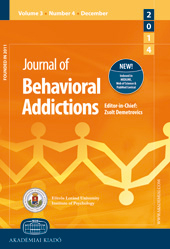Attention-deficit hyperactivity disorder and addictions (substance and behavioral): Prevalence and characteristics in a multicenter study in France
Attention-deficit hyperactivity disorder and addictions (substance and behavioral): Prevalence and characteristics in a multicenter study in France
Author(s): Lucia Romo, Joel Ladner, Gayatri KotbagiSubject(s): Behaviorism
Published by: Akadémiai Kiadó
Keywords: ADHD; behavioral addiction; student; addictions
Summary/Abstract: The aim of this study is to determine the possible links between attention-deficit hyperactivity disorder (ADHD) and the presence of concomitant addictions with or without substance use in a French student population. Measures. A battery of questionnaire measuring socioeconomic characteristics, university curriculum, ADHD (Wender Utah Rating Scale and Adult ADHD Self-Report Scale), substance consumptions (alcohol, tobacco, and cannabis), and behavioral addictions [(eating disorders (SCOFF)], Internet addiction (Internet Addiction Test), food addiction (Yale Food Addiction Scale), compulsive buying (Echeburua’s), and problem gambling (The Canadian Problem Gambling Index)] and measures of physical activity (Godin’s Leisure Time Exercise Questionnaire) was filled up by university students in Rouen and Nanterre in France. Results.A total of 1,517 students were included (472 from Paris Nanterre and 1,042 from Rouen). The mean age was 20.6 years (SD = 3.6) and the sex ratio male to female was 0.46. The prevalence of ADHD among the students (current ADHD with a history of ADHD in childhood) was 5.6%. A quarter (25.7%) of students had already repeated their university curriculum, compared to 42.2% among the students with ADHD. Students with possible ADHD had repeated classes more often and believed to have a lower academic level than the students without ADHD. Significant differences were found as students with ADHD were less likely to succeed in their studies (repeated classes more often) than non-ADHD students, and considered their academic level to be lower. They also had significantly higher scores on substance (alcohol, cannabis, and tobacco) as well as behavioral addictions (gambling, compulsive buying disorder, eating disorders, and Internet addiction). Conclusion. It seems essential to determine students’ problems and propose interventions adapted to students’ needs, in order to reduce the negative impact on their future academic and global successes.
Journal: Journal of Behavioral Addictions
- Issue Year: 7/2018
- Issue No: 3
- Page Range: 743-751
- Page Count: 9
- Language: English

